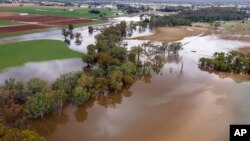Australia is considering setting up a disaster relief force to help the military cope with regular natural disasters.
The plan was suggested Tuesday by Australian Prime Minister Anthony Albanese, as communities in the country's southeast were evacuated due to flooding.
Residents in low-lying parts of the Australian state of Victoria north of Melbourne were told it was too late to leave as floodwaters rose following record-breaking rainfall.
Other residents were advised to move to higher ground after rivers burst their banks.
Landslide warnings also were issued.
In Yea, 115 km northeast of Melbourne, emergency services officials said the flooding was "probably a one in 200-year event.”
Some homes affected by flooding in 2022 were inundated again.
Victoria was the latest state to be battered by the wild summer weather.
More wet weather hit the northern state of Queensland as authorities there warned of intense rainfall and possible flash flooding.
The increasing incidence of natural disasters in Australia raised concerns among politicians, environmental activists and scientists about the impacts of global warming.
Tuesday, Albanese told the Australian Broadcasting Corp. that the government was considering creating a relief force to help the military respond to natural disasters.
“Victoria is also having flooding impact tragically as well, with several towns in central Victoria affected as well," he said, "Tragically in this beautiful country of ours, natural disasters are becoming more frequent and more intense. We were told that that would be an impact of climate change and unfortunately, we are seeing that play out in practice.”
In recent weeks, northeastern Australia was hit by record-breaking rainfall from an ex-tropical cyclone, while other parts of the country have been battling bushfires.
While the rain stopped in Victoria, rivers were expected to rise for several days.
Near Brisbane, severe thunderstorms Tuesday caused flash flooding.
The floods come after Australia endured some of its worst bushfires over the "Black Summer" of 2019-‘20, followed by a series of devastating floods on the country’s east coast in 2022.
Australia’s government has legislated a target to cut carbon emissions by 43% from 2005 levels by 2030 and to achieve net zero emissions by 2050.








